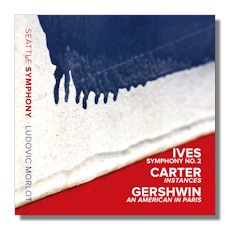
The Internet's Premier Classical Music Source
Related Links
-
Carter Reviews
Gershwin Reviews
Ives Reviews - Latest Reviews
- More Reviews
-
By Composer
-
Collections
DVD & Blu-ray
Books
Concert Reviews
Articles/Interviews
Software
Audio
Search Amazon
Recommended Links
Site News
 CD Review
CD Review
Seattle Symphony Orchestra

- Charles Ives: Symphony #2
- Elliot Carter: Instances
- George Gershwin: An American In Paris
Seattle Symphony Orchestra/Ludovic Morlot
Seattle Symphony Media SSM1003
One of three releases to introduce the Seattle Symphony's own recording label, this particular program accomplishes many things. First, the live recordings dating from 2011 to late 2013 give an effective overview of Ludovic Morlot's tenure from beginning to the present day. Second, the choice of music demonstrates the commitment to challenging repertoire that Seattle is known for. And third, this beautifully played and captured disc proudly shows the skill of both players and conductor in championing the music of America.
Benaroya Hall boasts some simply magnificent acoustics, and the Seattle Symphony is world-class. The Ives is superb, carefully balanced and excitingly conducted. The Seattle forces are stunning. Brass is warm and full, the winds dance enchantingly, and the strings sing radiantly. Attention to dynamics and detail allows Ives' writing to really take flight. There's none of the stiffness that sometimes is a challenge in this music, and everyone sounds like they are having a great time. I confess that I'm not usually the biggest fan of Ives, but this is a wonderful performance that carries a lot of conviction. The inner movements are as fresh and folksy as you could want – the Lento and Adagio are utterly beautiful – and the outer movements never drag or lose purpose. There are certainly other great recordings out there, but this is extremely good.
Instances follows on the program. I don't usually warm to Carter, either. His works tend to be serious to the point of dryness, and just because you can doesn't mean you should. But Instances is different. (Curiously, the only Carter work listed in Classical Net's review archive from a major American orchestra is Solti and Chicago in a long out-of-print collector's edition). Instances is mysterious, curious, and captivating all at once. Carter ingeniously uses various percussion – including piano – to create some very spooky sounds. For me, the most impressive component here, aside from the virtuoso response of the Seattle players, is Ludovic Morlot's unquestionable commitment to the cause. He gives this sometimes overly academic composer a real depth of feeling and weight. The solo passages are outstanding, balances are again excellent, and everyone works really hard to make this music mesh.
The Gershwin is the most familiar work on the program, and is also the least important as a result. Morlot and his players remain top-notch, but the music comes off as a touch straightforward in nature. Where the Ives was fresh and the Carter was committed, the Gershwin is a little routine. The solo work is beyond praise, and the sound is very fine. It's just not fun enough. This is serious music, but it needs a little more swagger. Could the fact that the performance is right from the beginning of the conductors' tenure have anything to do with the results? Never mind. For the Ives and Carter alone, this is essential for fans of 20th-Century American music.
Copyright © 2014, Brian Wigman




















